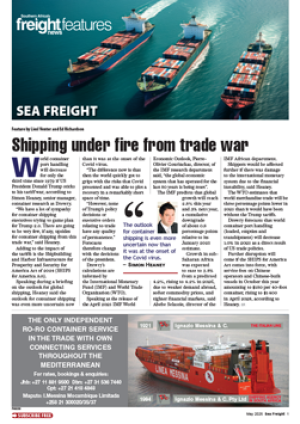The new tandem lift cranes
acquired by Transnet Port
Terminals (TPT) don’t
mean an automatic boost
to productivity at the
Durban container terminal,
according to two shipping
line executives who talked
to FTW.
These cranes are more
complex to use – both for
the crane operator and the
management of the terminal
where they are employed.
“Much is required in
both training and planning
needs,” FTW was told. “It
requires a lot of time and
effort on how to sweat the
assets properly if you are
to get a suitable return on
your investment.”
And one of the executives
was not at all sure that TPT
would display this ability.
“I have some doubts
about whether TPT will
have enough training and
the like to make the best
use of them,” he said. “If
not, then Transnet has just
got something shiny to play
with.”
Patrick McCarthy of
Liftech – who works
overseas primarily in
project management –
was also a supporter of
training. Writing for
Port Technology, he said:
“Proper training and
operating instructions
are required and need to
be clarified in the project
technical specifications.”
But TPT is confident
that it has the necessary
wherewithal.
Said Hector Danisa,
DCT terminal manager:
“The terminal has eagerly
awaited the arrival of the
cranes and has formulated
an operational plan to
put them to good use as
soon as they are fully
commissioned by the
capital projects team.
“As part of the readiness
preparations, a group
of terminal operations
and technical staff have
travelled to Shanghai,
China, for orientation
training. As with all new
technology, there will be an
initial learning curve before
the cranes are operated
at ‘full speed’, but we are
confident that our crane
operators will put these
cranes to good use.”
Looking at the pros
and cons of these cranes,
McCarthy said that ZPMC
cranes were currently
being used in several
Asian terminals, and
approximately 1 125
tandem-lift cranes were
operating around the world.
Operator controls are
more complicated, he
added. The original DHT40
controls were difficult to
use and limited production,
but new cab and control
arrangements seem to have
solved this problem.
McCarthy also noted
that, during DHT40
operation, workers needed
to remove more interbox
connectors (IBCs).
“This requires additional
personnel,” he said, “or
it would take more than
twice as long as for
conventional operations.
But higher production
rates are achievable with
cooperation.”
DHT40 cranes can
significantly increase
production, but this
depends on equally
productive yard operations,
he added. “A well-planned
yard is essential to
achieving the full potential.
Productivity simulations
depend on accurate dwell
times, container layout on
ship and in the yard, and
other data.”
McCarthy felt that
possible production could
be 60+ container moves per
hour, but the operator needs
proper training and the yard
needs to remove and deliver
containers when the crane
is ready – which he saw
as “a difficult challenge”.
However, McCarthy added,
a reasonable expected
production is at least 40
container moves an hour.
This would be almost
double TPT’s current
crane moves per hour
expectations.
Initial costs include
purchase and related
expenses, and are one
to two million US
dollars above those of a
conventional single-hoist
crane. Lifetime costs
include operation, energy,
and maintenance. “Only
one operator controls the
crane, so operator costs
are the same as for a
conventional crane,” he
said. “If additional workers
handle IBCs, this cost
increases.”
Power costs are higher,
but he does not see that as
twice that of a conventional
crane.
“DHT40 cranes present
both challenge and
opportunity,” he said. “But
new DHT40 crane owners
will benefit from lessons
learned by others.”
INSERT
‘A reasonable
expected production
is at least 40 container
moves an hour –
double TPT’s current
expectations.’
CAPTION
The recently arrived new cranes at DCT ... much is required in both traning and planning needs.

